 |
Home | Renaissance Milan | Tour's Map | Versione Italiana |
| Milan - Sforzesco Castle | ||||
The castle, which is one of the greatest monuments of the Renaissance period,
was started in the 14th century, when Galeazzo II Visconti
ordered building to begin on a stronghold. It was then extended by his successors,
Gian Galeazzo, Giovanni Maria and finally by Filippo Maria,
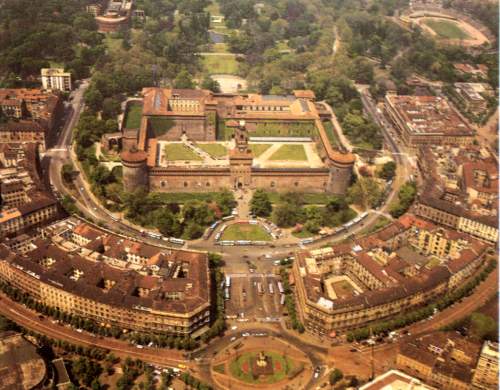 who had it altered and improved with the help of the architect Filippo
Brunelleschi, as he wished it to be used as the permanent residence of
the Visconti dynasty. After the death of Duke Filippo Maria (1447)
the stronghold was sacked by the Ambrosian Republic which had taken
over the government of the city.
who had it altered and improved with the help of the architect Filippo
Brunelleschi, as he wished it to be used as the permanent residence of
the Visconti dynasty. After the death of Duke Filippo Maria (1447)
the stronghold was sacked by the Ambrosian Republic which had taken
over the government of the city.In 1450, the soldier of fortune Francesco Sforza,
after the fall of the republic, took possession of the stronghold. He began
the reconstruction with the intention of creating a fortification for his own
defence but it was gradually transformed into an architecturally impressive
noble residence. To start with, the work was entrusted to Giovanni da
Milano with the assistance of Filippo Scorzioli and in 1451 the
direction of the works passed to Jacopo da Cortona. In 1452 the Prince
engaged the Florentine architect Filarete to construct and decorate
the middle tower of the castle which however
was begun two years later, when work on the building under the direction of
Bartolomeo Gadio da Cremona resumed. After the death of Francesco Sforza
(1466) his son Galeazzo Maria succeeded him and had the work continued
under the architect Benedetto Ferrigni, also from Florence, to whom we
owe the loggia, the great staircase of honour, the portico of the Elephant,
the chapel and the rear end of the Rocchetta.
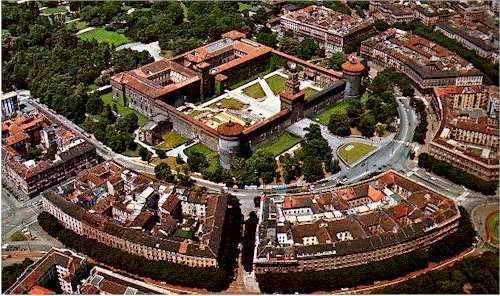 The decoration was entrusted to painters of the Dukedom. Under the regency
of Bona di Savoia, the tower was built to which she gave her name
(1476). With the rise to power of Ludovico il Moro the fourth son
of Francesco Sforza, the castle became one of the most splendid residences,
decorated by Bramante, the great Leonardo da Vinci and numerous
other artists summoned to work there.
The decoration was entrusted to painters of the Dukedom. Under the regency
of Bona di Savoia, the tower was built to which she gave her name
(1476). With the rise to power of Ludovico il Moro the fourth son
of Francesco Sforza, the castle became one of the most splendid residences,
decorated by Bramante, the great Leonardo da Vinci and numerous
other artists summoned to work there.After Ludovico il Moro's fall (1499), the magnificent palace
was occupied by the French forces commanded by marshal Gian Giacomo Trivulzio
and the beginning of the destruction of the splendid castle commenced. In 1521,
a gun powder explosion caused the destruction of the
central tower built by Filarete. During the Spanish domination
(16th-17th century) the castle underwent further
transformation and addition of buildings, becoming a military fortress. Charles
V had a new rampart built which connected it to the new walls of the city.
At the end of the 16th century the stronghold was surrounded by six
bulwarks. At the beginning of the 17th century the moat was put in
order and the covered road along the external border, and six detached ravelins
were built. In 1800, Napoleon demolished the Spanish additions and only
the original Sforza Castle was left standing. With the join of the Lombardy
to the Regno di Sardegna, the old castle became a barracks and in 1880
was sentenced to complete destruction. During the following years, however, a
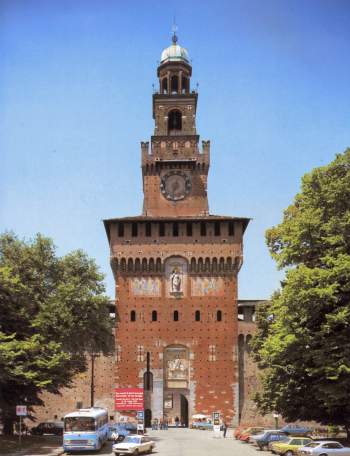 large number of citizens and the interest of the Lombard Historical Society
foiled all attempts in this direction, so much so that in 1893 the architect
Luca Beltrami, who had already put forward a project, began a radical
reconstruction. In the three nuclei of the historical building - the
Parade Ground, the
Rocchetta and the Ducal Court - he
sited the Civic Institute for Art and History. Although it was damaged
once more during the last war, the Sforza Castle was restored and became a
museum.
large number of citizens and the interest of the Lombard Historical Society
foiled all attempts in this direction, so much so that in 1893 the architect
Luca Beltrami, who had already put forward a project, began a radical
reconstruction. In the three nuclei of the historical building - the
Parade Ground, the
Rocchetta and the Ducal Court - he
sited the Civic Institute for Art and History. Although it was damaged
once more during the last war, the Sforza Castle was restored and became a
museum.The Castle exterior
In the middle of the fašade with its front towards the centre of city rises the
so-called Filarete Tower (called also the Clock Tower) which is 70
metres high. It was reconstructed at the beginning of the 20th century
by the architect Luca Beltrami, and was given back the appearance it had before
the destruction of 1561. It's quadrangular in shape with two upper storeys, each
one narrower than the lower, culminating in a small cupola. Above the great door
is a bas-relief by Luigi Secchi representing King Umberto I on
horseback (1916). Higher-up, under the first battlements is St. Ambrose
amidst the coats of the arms of the six Sforza dukes. Six magnificently ornamented
and richly decorated marble and brick mullioned windows are set into the powerfully
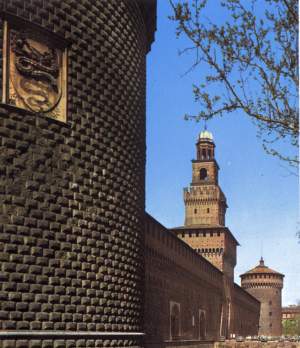 structured front walls of the castle, which stretch out left and right from the
central Clock Tower, leading to the two massive cylindrical corner towers dressed
in rough-hewn blocks of stone. They are 31 metres high, crowned with battlements
and decorated with the great marble coat of arms with the Visconti-Sforza
grass snake. The sides and the rear have the same characteristics as the fašade
and at the level of the Rocchetta and the
Ducal Court are two series of large gothic
windows decorated with brickwork frames. The corner towers at the back are
called Torre Falconiera to the right and Torre Castellana (or of the
Treasure) to the left; they are square with large windows. At the centre of
the side facing the Sempione Park there is the great Porta del Barco.
On the left side, next to Porta di Santo Spirito (Door of the Holy Spirit),
picturesque restored ruins of a ravelin. On the right is the Porta dei Carmini
with a drawbridge and the bridge of Ludovico il Moro.
structured front walls of the castle, which stretch out left and right from the
central Clock Tower, leading to the two massive cylindrical corner towers dressed
in rough-hewn blocks of stone. They are 31 metres high, crowned with battlements
and decorated with the great marble coat of arms with the Visconti-Sforza
grass snake. The sides and the rear have the same characteristics as the fašade
and at the level of the Rocchetta and the
Ducal Court are two series of large gothic
windows decorated with brickwork frames. The corner towers at the back are
called Torre Falconiera to the right and Torre Castellana (or of the
Treasure) to the left; they are square with large windows. At the centre of
the side facing the Sempione Park there is the great Porta del Barco.
On the left side, next to Porta di Santo Spirito (Door of the Holy Spirit),
picturesque restored ruins of a ravelin. On the right is the Porta dei Carmini
with a drawbridge and the bridge of Ludovico il Moro.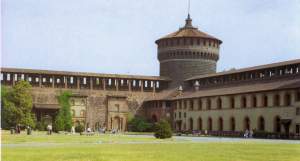
The Castle interior
The doorway, under the Tower of Filarete, leads
into the grand and picturesque Parade Ground, now a garden, was once used to
exercise the Sforza troops. The internal front of the tower is distinguished by a
balcony with a three-mullioned window, whilst along the left side of the wall runs
a construction which act a support. Three buildings, with a dry moat in front of them,
close the bottom of the courtyard. To the left stands the
Rocchetta, a fortified building in which the Sforza took refuge in
dangerous moments. Almost at the centre stands the Tower of Bona di Savoia
36 metres high and commissioned by the widow of Galeazzo Maria Sforza in 1477. To
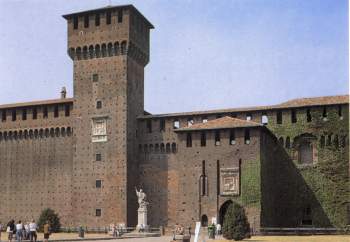 the right, the palace of the Ducal Court, the
residence of the Sforza in time of peace and tranquillity. The solitary statue in
front of the moat is St. John Nepomucenus erected in 1729. At the sides of
the great square two doors with a drawbridge that crosses the external moat. The
right one is Porta dei Carmini decorated with architectural fragments of
different epochs. The left one is the Porta di Santo Spirito (Gate of the
Holy Spirit).
the right, the palace of the Ducal Court, the
residence of the Sforza in time of peace and tranquillity. The solitary statue in
front of the moat is St. John Nepomucenus erected in 1729. At the sides of
the great square two doors with a drawbridge that crosses the external moat. The
right one is Porta dei Carmini decorated with architectural fragments of
different epochs. The left one is the Porta di Santo Spirito (Gate of the
Holy Spirit).The Ducal Court
The access is through the door surmounted by a great Sforza coat of arms, which
rises upon the site of the old Jovian Gate and leads into the vestibule where
sculptures and fragments of various Milanese buildings are kept. On the wall one
can still see the fresco of the Crucifix between Saints by an unknown
Lombard (1470-1480) showing the sponsor, Ambrosino da Longhirana,
who was at that time the keeper of the castle for Galeazzo Maria Sforza and Bona
di Savoia. From the vestibule one enters the stupendous courtyard of the Ducal
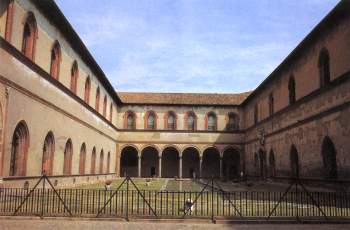 Court, flanked on three sides by a two storey construction with two rows of
pointed arch windows. The ground floor of the end wall is graced by Renaissance
Elephant Door, which owes its name to the frescoed elephant on the wall by
Benedetto Ferrini (1473). He also designed the two-storey graceful loggia at the
beginning of the left wing, called the Loggia of Galeazzo Maria, that stands
above the vestibule of the great staircase.
Court, flanked on three sides by a two storey construction with two rows of
pointed arch windows. The ground floor of the end wall is graced by Renaissance
Elephant Door, which owes its name to the frescoed elephant on the wall by
Benedetto Ferrini (1473). He also designed the two-storey graceful loggia at the
beginning of the left wing, called the Loggia of Galeazzo Maria, that stands
above the vestibule of the great staircase.The Rocchetta
The Rocchetta is a fortress within a fortress surrounded on three sides by
porticoes. The right one was constructed by the Florentine Benedetto Ferrini (1466-
1476) by order of Galeazzo Maria, the one opposite is by Filarete and the left one
was begun by Bernardino da Corte in 1495 and finished by Bramante under the
orders of Ludovico il Moro. From the courtyard, through an archway, one enters the
Treasure Room, so called, because the ducal treasure was kept there. On the
walls one can see the frescoes of the Lombard school and a damaged fresco by
Bramante, showing Argus whit a hundred eyes guarding the door leading to a small
room in which the most precious jewels of the Duke were kept. |
| Santa Maria delle Grazie | Last Supper by Leonardo da Vinci | Sforzesco Castle | Sforzesco Castle Museums | Borromeo Palace | Santa Maria in San Satiro | Ca' Granda | Shopping |